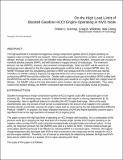On the High Load Limit of Boosted Gasoline HCCI Engine Operating in NVO mode
Author(s)
Scaringe, Robert J.; Cheng, Wai K.; Wildman, Craig B.
DownloadCheng_On the.pdf (534.5Kb)
OPEN_ACCESS_POLICY
Open Access Policy
Creative Commons Attribution-Noncommercial-Share Alike
Terms of use
Metadata
Show full item recordAbstract
The high load limit of a boosted homogeneous-charge-compression-ignition (HCCI) engine operating on negative-valve-overlap (NVO) was assessed. When operating under stoichiometric condition with no external dilution, the load, as measured by the net indicated mean effective pressure (NIMEP), increased with increase in manifold absolute pressure (MAP), and with decrease in trapped amount of residual gas. The maximum pressure rise rate (MPRR), however, also increased correspondingly. When the MAP and the amount of residual gas were adjusted so that the engine operating point could be held at a constant MPRR value, the NIMEP increased with the simultaneous decrease in MAP and residual until the misfire limit was reached. Therefore if a MPRR ceiling is imposed, the high load limit of an HCCI engine is at the intersection of the constraining MPRR line and the misfire line. Dilution with cooled exhaust gas recirculation (EGR) shifted both the MPRR line and the misfire line so that the intersection point would be at a higher MAP and a higher level of dilution. The NIMEP value at this new intersection point, however, did not change substantially. Thus using cooled EGR dilution strategy, the MPRR constrained high load limit is approximately neutral to boosting.
Date issued
2010-04Department
Massachusetts Institute of Technology. Department of Mechanical EngineeringJournal
SAE International Journal of Engines
Publisher
SAE International
Citation
Scaringe, Robert, Craig Wildman, and Wai K. Cheng. On the High Load Limit of Boosted Gasoline HCCI Engine Operating in NVO Mode. SAE International Journal of Engines, 3(1):35-45, 2010.
Version: Author's final manuscript
ISSN
1946-3944
1946-3936